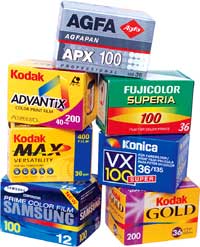 With digital technology making things easier, even the most dedicated professionals are making the switch. Going straight from the camera to computer programs like Adobe Photoshop eliminates the entire developing process and has made editing a breeze.
With digital technology making things easier, even the most dedicated professionals are making the switch. Going straight from the camera to computer programs like Adobe Photoshop eliminates the entire developing process and has made editing a breeze. Gopal Chitrakar, photo correspondent with Reuters, began taking pictures 25 years ago. At the time it was vital for any good photographer to know the darkroom process, which involved an enormous amount of time and effort. Now, with digital technology, he is the master of his own lab and marvels at how fast, economical and easy the process has become. "It's just my photograph and me," says Chitrakar as he opens a computer file and shows us his recent pictures of a Himalayan panorama (see pic top). "This picture was possible only with a software that allowed me to integrate seven separate images."
Digital print facilities are useful for those of us who prefer to have hardcopies. Unfortunately, most run-of the-mill labs offer a consumer quality ink jet printer that results in a grainy, raw output, so it definitely helps to know who does it right.
Though they had a good digital mini lab, Photo Concern brought in a Digital Image Processing System (DIPS) to ride the digital wave. The Kodak technology cost Rs 2 million, but the print quality is unparalleled. Though it relies on the same chemical process as a manual lab, it's an entirely digital set up from scanner to LED printer for uniform colour tone. And if they're doing the shoot for you, they'll use their own camera, a Fuji S2 Pro with 12.1 megapixels. DIPS prints from any digital media, including mobile phones. It's possible to retouch, enlarge photos or restore old colour or black and white pictures too. Maximum print size is 20"x30" and a postcard size costs Rs 30 per print.
 It is a bit pricier for less work than regular prints, but technology doesn't always come cheap. Studio 7 uses the Konica QD 21 mini lab system for graphic designers, ad agencies and anyone who requires quality digital work, printing a maximum 12"x18" size at 300dpi. But, as technician Niraj Dhungel cautions, if the resolution of the image is low, there are limits to how much it can be improved. Unlike the liquid chemicals many other systems use, QD21 uses tablet chemicals ensuring the photograph can withstand extreme sun exposure, heat and even water. Special features include value-added prints like calendars, greeting and business cards. Postcard size snaps run at Rs 15 each.
It is a bit pricier for less work than regular prints, but technology doesn't always come cheap. Studio 7 uses the Konica QD 21 mini lab system for graphic designers, ad agencies and anyone who requires quality digital work, printing a maximum 12"x18" size at 300dpi. But, as technician Niraj Dhungel cautions, if the resolution of the image is low, there are limits to how much it can be improved. Unlike the liquid chemicals many other systems use, QD21 uses tablet chemicals ensuring the photograph can withstand extreme sun exposure, heat and even water. Special features include value-added prints like calendars, greeting and business cards. Postcard size snaps run at Rs 15 each. AGFA is expecting the arrival of its AGFA DiLab 2 in a few months. The processing is a regular chemical job, but prints are exposed by laser. It's got a built-in scanner to limit human error and prints 400dpi. You can ask for prints on digital photo paper at a maximum 12"x18" print, but it will most likely come to double the price of regular film prints, estimates Sarada Amatya, director at Colour Link Lab in Thamel.
Chitrakar, who teaches communications at Tribhuban University, sees only one drawback with digital: "It's so easy to manipulate an image. If you are unethical you could destroy someone's life with it."
(Sraddha Basnyat)


